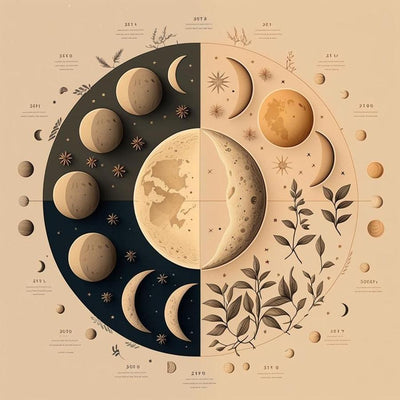Lunologie : Quelles sont les différentes phases de la lune ?
4 janvier 2023

Dans de nombreuses traditions, la Lune est considérée comme sacrée. Son influence sur les marées et sur l’organisme humain a rapidement été remarquée par nos ancêtres. Le cycle de notre satellite a également été rapproché du cycle menstruel, faisant de cet astre changeant un symbole de féminité. Pour améliorer leur quotidien, certaines femmes exploitent ainsi les énergies propres aux différentes phases lunaires et en particulier de la pleine Lune. Mais qu’est-ce que la lunologie ? Décryptage.
Définition : Qu’est-ce que la Lunologie ?
La lunologie correspond à une branche de l’astrologie consistant à tirer le meilleur parti des énergies libérées par la Lune au cours de chaque lunaison. Dans son ouvrage intitulé La lunologie. Comment déployer la magie des cycles lunaires, l’astrologue Yasmine Boland explique qu’en vivant au rythme des huit phases de la Lune, il est possible de s’épanouir et d’être en harmonie avec sa féminité.
Le cycle menstruel et la Lune demeurant intimement liés, utiliser l’influence de cet astre pour poser des intentions ou réaliser certaines activités peut se révéler bénéfique. Au moment de la nouvelle Lune, vous pouvez formuler des souhaits et des résolutions. Puis, vous travaillerez avec les énergies des phases lunaires suivantes pour qu’ils s’accomplissent lors de la pleine Lune.
Lunologie : Quelles sont les différentes phases lunaires ?
En lunologie, il est important de connaître le fonctionnement du cycle de la Lune afin de savoir quel jour se montre le plus propice à l’exécution de telle ou telle activité. Chaque lunaison dure 29 jours et demi environ et se divise en huit phases lunaires.
1. La nouvelle Lune
Le cycle lunaire débute par la nouvelle Lune, aussi appelée « Lune noire ». Durant cette phase, notre satellite se trouve entre le Soleil et la Terre et reste donc invisible à l’œil nu.
2. Le premier croissant de Lune
Ensuite, le Soleil commence à illuminer la face visible de notre satellite. La Lune prend la forme d’un fin croissant qui va s’agrandir de jour en jour. Cette phase est ainsi appelée : « premier croissant de Lune ».
3. Le premier quartier de Lune
Au moment du premier quartier de Lune, l’astre de la nuit a parcouru le quart de sa révolution mensuelle. Vous pouvez ainsi admirer la moitié de sa partie visible. Son lever se situe aux alentours de midi et son coucher vers minuit.
4. La Lune gibbeuse croissante
Lorsque la quasi-totalité de la Lune est visible dans le ciel et qu’elle se montre très brillante, on l’appelle « Lune gibbeuse croissante » (c’est-à-dire « arrondie »). Cet événement se produit entre le dixième et le quatorzième jour du cycle.
5. La pleine Lune
La pleine Lune correspond à la phase au cours de laquelle notre satellite se situe à l’opposé du Soleil par rapport à la Terre. Ainsi, sa face visible se montre totalement éclairée. Elle se lève généralement au moment du coucher du Soleil et se couche vers son lever.
6. La Lune gibbeuse décroissante
La Lune entame ensuite son voyage retour vers le Soleil. Elle entre dans sa phase décroissante, aussi appelée Lune disséminante, et sa surface illuminée va rétrécir progressivement. C’est la « Lune gibbeuse décroissante » qui se lève de plus en plus tard chaque nuit.
7. Le dernier quartier de Lune
Au début du troisième quartier de Lune, notre satellite est arrivé aux trois quarts de sa révolution. Vous pouvez ainsi observer l’autre moitié de sa face visible. Son lever se produira vers midi et son coucher aux alentours de minuit.
8. Le dernier croissant de Lune
Enfin, la Lune retrouve sa forme de croissant qui décroît jusqu’à disparaître complètement du ciel. Cette phase se nomme « dernier croissant de Lune », mais aussi « Lune balsamique ». Le cycle lunaire s’achève et peut ainsi recommencer avec la nouvelle Lune.
Lunologie selon les mois de l’année
Très proches de la nature, les Amérindiens avaient l’habitude de vivre au rythme des différentes phases de la Lune et recouraient déjà à la lunologie. Ils ont ainsi donné des noms aux pleines Lunes survenant au cours des douze mois de l’année et leur ont attribué des caractéristiques liées à leur énergie.
Janvier : Lune du loup
La Lune du loup ou Lune d’hiver correspond à la première pleine Lune de l’année. Durant cette période, les loups rôdaient très souvent autour des campements amérindiens. Cette Lune incarne le renouveau et incite à repartir de zéro et à mettre en place de nouveaux projets.
Février : Lune de neige
La Lune de neige ou Lune de la faim caractérise la pleine Lune du mois de février. Au cœur de l’hiver, les Indiens d’Amérique éprouvaient en effet des difficultés à trouver de la nourriture et à chasser. Ce moment demeure propice à l’introspection, à l’entraide familiale ainsi qu’à l’évacuation de tout bagage émotionnel encombrant.
Mars : Lune de ver ou Lune vermoulue
La pleine Lune se produisant lors du mois de mars est désignée par les dénominations Lune de ver ou Lune vermoulue. Elle annonce le dégel et l’arrivée du printemps avec les vers de terre qui remontent à la surface. Cette lune incarne donc la renaissance et le renouveau. Elle est également synonyme de bonnes nouvelles.
Avril : Lune rose
La Lune rose est la pleine Lune du mois d’avril. Aussi appelée Lune du lièvre, elle apparaît dans le ciel nocturne lorsque les premières fleurs sauvages roses du printemps remplissent les prairies. Elle symbolise la croissance et l’épanouissement des relations familiales, amoureuses et amicales.
Mai : Lune des fleurs
La pleine Lune du mois de mai correspond à la Lune des fleurs. Cette désignation fait référence à l’apogée du printemps et à la pleine floraison. Remplie d’énergie, elle apporte abondance et prospérité. C’est la période idéale pour réaliser des intentions ou pour prendre des décisions relatives à sa vie personnelle ou professionnelle.
Juin : Lune des roses
La Lune des roses ou des fraises survient au mois de juin. Il s’agit d’une période plus chaude et douce propice à l’amour et à la communion. Restez à l’écoute de vos émotions, identifiez vos désirs et mettez tout en œuvre pour les matérialiser.
Juillet : Lune des daims
La pleine Lune illuminant le ciel de juillet est appelée Lune des daims. Cette appellation fait en effet référence aux jeunes daims dont les bois commencent à se développer. Elle correspond à la saison des moissons et incite à récolter le fruit de son travail.
Août : Lune de l’esturgeon
La Lune de l’esturgeon caractérise la pleine Lune du mois d’août. Elle tire son nom du poisson qui était pêché durant cette période par les tribus amérindiennes résidant autour des Grands Lacs. Elle est associée à l’abondance et à la générosité. C’est le moment idéal pour s’ouvrir aux autres, mais aussi à de nouvelles propositions.
Septembre : Lune des moissons
La Lune des moissons correspond à la pleine Lune la plus proche de l’équinoxe d’automne. Elle incite à passer à l’action, à revoir ses résolutions, mais aussi à saisir les opportunités qui se présentent.
Octobre : Lune du chasseur
Au mois d’octobre, les Indiens d’Amérique tiraient parti des énergies de la Lune du chasseur. Après avoir terminé leurs travaux de récolte, ils bénéficiaient d’une vue dégagée sur les champs et pouvaient facilement y chasser. Lors de cette pleine Lune, vous pouvez commencer à dresser un premier bilan de l’année écoulée et prendre le temps de relâcher la pression.
Novembre : Lune du castor
La Lune du castor survient en novembre, lorsque ce rongeur d’Amérique du Nord commence à organiser son hibernation. Les températures baissent et les premières gelées se font sentir. Prenez le temps de vous préparer à l’hiver en vous tournant vers votre famille et vos proches. La nature se met au repos, pourquoi pas vous ?
Décembre : Lune froide
La dernière pleine Lune de l’année a été nommée Lune froide par les Amérindiens. Le froid s’est installé, les conditions météorologiques se montrent difficiles et les nuits s’allongent. Cette période est propice à l’introspection et à la prise de recul. Les énergies de cette lune convenant particulièrement aux enfants, prenez le temps de réaliser des activités avec eux et de leur transmettre vos connaissances.
La FAQ de la lunologie
Qu’est-ce que la Lune bleue ?
La Lune bleue est une pleine Lune supplémentaire survenant lors d’une année comportant treize pleines Lunes au lieu de douze. Elle n’est donc pas associée à un mois en particulier.
Qu’est-ce que la Lune rouge ?
La Lune rouge ou Lune de sang correspond à une éclipse lunaire totale durant laquelle l’astre de la nuit se teinte de rouge.
Qu’est-ce qu’une super Lune ?
Une super Lune désigne une pleine Lune située au plus proche de la Terre. Elle vous semblera donc beaucoup plus grande que d’ordinaire.


Commentaires